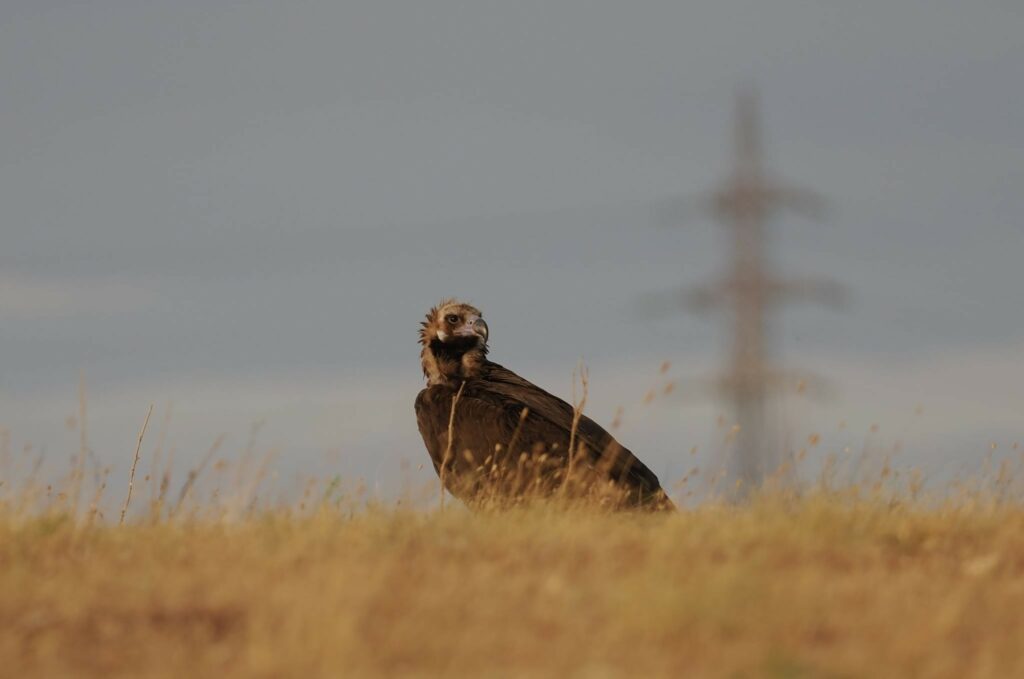A second pair of Cinereous Vulture was found nesting in the Douro Canyon – consolidating what looks like the establishment of a new breeding nucleus for this species. More, the new pair is breeding in an artificial platform!
One of the artificial nests installed in the Douro International Natural Park in January already has occupants: a breeding pair Cinereous Vultures. The nests were installed as part of the LIFE Rupis vulture conservation project. As a result of the fires that devastated the Lagoaça region in 2017, and that destroyed some of the existing nests of the first breeding pair in the region, established in 2012, as well as many of the tall trees that are in good condition for these birds to nest, the team at Sociedade Portuguesa para o Estudo das Aves (SPEA) undertook the work to create new nest sites, with the help of local conservationists. The pair of Cinereous Vultures that has now settled in one of these artificial nests doubles the number of breeding pairs in the Douro International Natural Park, reinforcing the likelihood of a new colony of this globally threatened species being installed in the north-east of Portugal.
“The fact that this nest has been occupied so quickly shows the importance of providing safe places where these threatened birds can nest, especially following devastating events such as the fire of 2017”, says Joaquim Teodósio one of the coordinators, from lead LIFE Rupis project partner Sociedade Portuguesa para o Estudo das Aves (SPEA).
Building nests for Cinereous Vultures
Artificial nests are elevated platforms installed at the top of the canopy of selected trees where the Cinereous Vultures can nest and keep their young safe. As part of the LIFE Rupis project, this specialised work was carried out by the company Oriolus with the support ICNF staff, and four of these platforms were built in strategic locations in the Douro International Natural Park. Shortly afterwards, the new couple settled in one of them.
Hopes for a new colony
These new inhabitants of the Douro Canyon join the other couple of Cinereous Vultures in the region, who have been observed, since they settled in the area seven years ago, by teams from the two parks covered by LIFE Rupis: the Douro International Natural Park (managed by Portugal’s Institute for Nature Conservation and Forests) and the Arribes del Duero Natural Park (Junta de Castilla y León). When this first couple made the Douro their home in 2012, it surprised the teams by settling about 100 km from the nearest colonies, located in Spain.
Cinereous Vulture usually live in colonies with dozens of individuals. Sometimes, newly formed couples move away from a colony, starting a new nucleus, but usually these new nuclei form 10 or 20km from the original colony – not 100km!
The hope of the LIFE Rupis team is that both couples will breed successfully, and that this summer two more chicks will join the one that was successful last year, after their parents lost their 2017 chick in the fire. In the long term, the team hopes that this new generation, when it reaches maturity, will also settle in the region and that it will be joined by birds from other origins that sometimes disperse into the Douro, so that little by little a colony of Cinereous Vultures will be established in the north-east of Portugal. For this endangered species, a new population in Portugal would be excellent news, and a significant contribution to the recovery of the species in Europe
Cinereous Vultures in Portugal

Cinereous Vultures became extinct as breeding species in Portugal in the 1970s, mostly due to the use of poisoned carcasses targeting unwanted predators. An increasing population in Spain saw the species first return to breed in central Portugal (Tejo Internacional) in 2010 (where now there is a small colony of about 10-15 pairs), and then in north-eastern Portugal (now with two breeding pairs). Then in 2015 they also started breeding in southern Portugal at there is a population of around eight breeding pairs, in Herdade da Contenda, a large estate owned and managed by the Moura Municipality. In total there are around 25 breeding pairs in Portugal.

The LIFE Rupis conservation project, led by Portuguese wildlife organisation Sociedade Portuguesa para o Estudo das Aves (SPEA), and funded by the European Union’s LIFE Fund and the MAVA Foundation, is working in the cross-border Douro region of Spain and Portugal to protect and strengthen the populations of Egyptian vultures and Bonelli´s eagle. With around 135 breeding pairs, the region has one of the largest population of Egyptian vultures in Europe. Creating a network of feeding stations, improving habitat and nesting sites as well as tackling the major threats of electrocution from electricity pylons and illegal wildlife poisoning, the LIFE Rupis project will strengthen the population and improve breeding rates.




